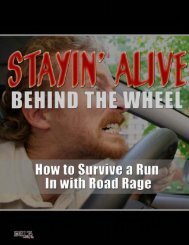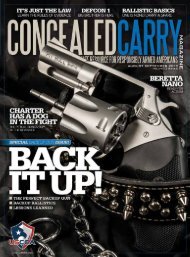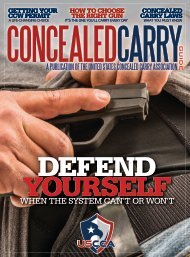Download This Issue - US Concealed Carry
Download This Issue - US Concealed Carry
Download This Issue - US Concealed Carry
You also want an ePaper? Increase the reach of your titles
YUMPU automatically turns print PDFs into web optimized ePapers that Google loves.
The Sayoc Tactical Group regularly<br />
offers seminars on Counter Edged<br />
Weapon Tactics to prepare good<br />
people to survive edged weapon<br />
attacks by bad people.<br />
Throughout human history, oppressed<br />
groups of people in a myriad<br />
of cultures were forced to find accessible<br />
tools to use as weapons. Hence<br />
stick, edged weapon as well as empty<br />
hand fighting techniques evolved into<br />
well developed martial art forms such<br />
as those of Japan, the Philippines, and<br />
Indonesia. These martial arts cultures<br />
developed techniques for aggressively<br />
deploying edged weapons in a fight and<br />
for defending against edged weapon<br />
attacks. As a student of edged weapon<br />
combatives with the Sayoc Tactical<br />
Group (STG) (www.SayocTactical.<br />
com), I have been fortunate to study<br />
some of these techniques with like<br />
minded partners.<br />
Edged weapon realities<br />
At contact distances, relying solely<br />
on your hands or any other body parts<br />
in the face of an edged weapon attack<br />
should be a last resort. Before that, we<br />
should have exhausted verbal dissuasion<br />
and any other attempt to abort or<br />
escape the situation. Unfortunately, in<br />
“gun-free zones” and jurisdictions that<br />
do not permit carrying firearms, the<br />
law abiding citizen is really on his or<br />
her own in a close quarter blade confrontation.<br />
In such a situation, getting<br />
an impact or edged weapon into play<br />
would be our next goal. However, if this<br />
cannot be done, then we are in an empty<br />
hand versus blade confrontation.<br />
Avoid jumping too quickly into an<br />
“empty hand versus blade” training<br />
mentality because there seldom is a<br />
good outcome to an empty hand versus<br />
blade confrontation; rather, it is<br />
a least bad outcome—you are most<br />
likely going to get cut and the question<br />
is how to minimize the damage. In the<br />
real world, it is false confidence to assume<br />
that you will be able to reliably<br />
deploy empty hand defenses and knife<br />
disarms and remain intact physically.<br />
MAY/JUNE 2011 n CONCEALED CARRY MAGAZINE n <strong>US</strong>CONCEALEDCARRY.COM<br />
Knife attacks happen very fast—faster<br />
than the eyes can track. Therefore, always<br />
keep avoidance in mind. Learn to<br />
recognize precursors to attacks and to<br />
violent behavior. Anyone who teaches<br />
empty hand tactics in this context without<br />
mentioning this is irresponsible.<br />
The person who has the blade has<br />
an advantage. Imagine for a moment<br />
that you are fighting your clone. You<br />
are empty handed and your clone has<br />
an edged weapon. You will lose because<br />
the “you” with the blade will be a more<br />
dangerous fighter than the “you” without<br />
the blade. What this means is that<br />
if you want to come out the winner in a<br />
close-quarter fight with a blade wielding<br />
attacker, you have to be better than<br />
that person with the blade.<br />
The “De-escalation mindset“<br />
Situational awareness is essential to<br />
staying safe and surviving in the world.<br />
In order to survive an attack and win the<br />
57
















